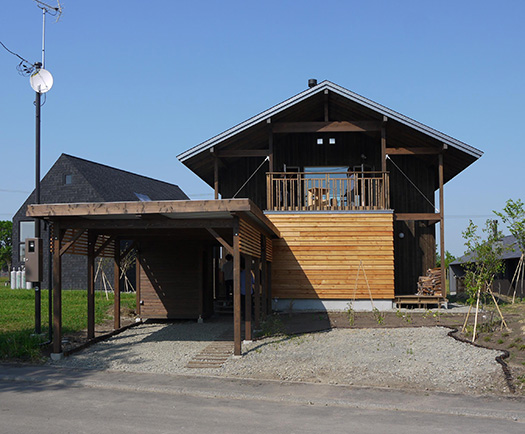
現代ではひとが住む「都市」や「街区」選択は一応,自由選択であり実際にそのように「好きな場所に住む」という選択を実践されている方も多くいる。とくに北海道では本州地域や海外からの移住、半移住者という存在もケースが多い。経済的にある程度の成功を得られて「住む土地」選びをかなり自由に発想されて大自然の魅力をもとめて移住されるケースもある。そういうケースではかなり自由度の高い住宅になるので見どころも多く、取材することが比較的に多い。住宅雑誌として永年取材してきてこのことは興味深く思う。海外著名IT企業の日本法人のトップの方の住宅取材などもした経験がある。
象徴的にはニセコ地域、一般的には羊蹄山周辺地域などではかなり多数の別荘とか、普段はホテル的に貸し出しながら所有者自身も冬場のスキーシーズンだけ居住して使う「コンドミニアム」も多数ある。そのような需要対応の海外資本からの住宅発注というのも北海道ではけっこう多い。そういった需要に対応する業界の対応力も求められていくのだろうと思います。人口減少社会ニッポンのなかで、こういった新規需要を前向きに捉えて対応力を磨いていくのもアリ。
そういった意味では広義の北海道「ムラ」が世界の中で評価を得ているとも言えるし、そもそもが日本のなかでも「新開地」である地域なのでまだまだ「移住」需要が継続しているともいえるのだろうか。
この時期、千歳空港では海外の方が利用される割合が非常に高いと思います。また円安傾向から世界中の観光客の増加は全国的にも顕著で、交通的に京阪神地域からはかなり遠距離である2回の熊野探訪でも外国人ツアーとか、少人数での海外旅行客などに多く遭遇した。
もちろん住宅企業としては「地域密着」が基本であるのだけれど、北海道の場合、そもそも大部分が「移住者」によって地域形成されてきているので、人間社会意識「ムラ」意識としても、こだわりのなさ、開放性が根っこにあるのだと思う。中国資本による土地買収というのは危険性が高いけれど、一般的な海外からの投資については柔軟に対応するのが自然ではないだろうか。
交通手段が飛躍的に発展した現代世界では、今後ともこうした需要は継続する可能性が高い。現実にニセコにとどまらず、旭川近郊の東川、富良野地域など、IT社会化の趨勢が強まっていて眺望の良い山をまるごと住宅用に購入して家を建てて、仕事はリモート環境で行うという事例もある。ときどき東京に出張して「打合せ」の必要性があるから飛行場とのアクセスは重要、とされている。
現代のムラ選択は進化スピードが速いのではないだろうか。
<画像は北海道らしいウッドハウス〜南幌町の街並みより>
English version⬇
Overseas Eyes on Hokkaido’s Great Outdoors: Mura and Choosing a Comfortable Place to Live – 4
Housing demand in a society with a declining population. The transportation system has been dramatically developed and costs have been reduced. The IT system is transforming work and increasing the freedom to choose a mura.
Today, people are free to choose the “city” or “district” in which they live, and there are many people who actually choose to “live where they want”. Especially in Hokkaido, there are many immigrants and semi-immigrants from the Honshu region and overseas. There are also cases where people who have achieved a certain degree of economic success and are free to choose a “place to live” and move to Hokkaido for its natural attractions. In such cases, there are many highlights to be seen, and we cover them more often than not. This is an interesting fact that I have been covering for many years as a housing magazine. I have also had the experience of covering the housing of the top executives of Japanese subsidiaries of prominent overseas IT companies.
Symbolically, in the Niseko area and generally around Mt. Yotei, there are quite a few vacation homes and “condominiums” that are usually rented out as hotels, with the owners themselves only living there during the winter ski season. In Hokkaido, there are also quite a few orders for housing from foreign capital to meet such demand. I believe that the industry will also be required to respond to such demand. In Japan, a society with a declining population, it is also possible to take a positive view of such new demand and hone one’s ability to respond to it.
In this sense, it can be said that Hokkaido’s “mura” in the broad sense of the word is gaining recognition around the world, and since the region is a “newly developed area” within Japan to begin with, can it be said that demand for “immigration” is still continuing?
During this season, I believe that the percentage of overseas visitors to Chitose Airport is very high. In addition, due to the trend toward a weaker yen, the increase in tourists from around the world is also noticeable nationwide, and we encountered many foreign tours and small groups of overseas tourists during our two Kumano explorations, which are quite far from the Keihanshin area in terms of transportation.
Of course, as a housing enterprise, “community-based” is the basic concept, but in the case of Hokkaido, the majority of the people have been “immigrants” who have formed the region, so I believe that a sense of “mura” or “village” in human society is also rooted in a lack of commitment and openness. Although land acquisition by Chinese capital is highly risky, I think it is natural to be flexible in dealing with foreign investment in general.
In today’s world, where transportation has developed by leaps and bounds, it is highly likely that such demand will continue in the future. In fact, not only in Niseko, but also in the Higashikawa and Furano areas near Asahikawa, where the trend toward an IT-oriented society is gaining momentum, people are buying entire mountains with great views for their homes, building houses, and working remotely. In some cases, people buy an entire house in a mountain with a great view and build a house to work remotely.
The choice of mura in today’s world is evolving at a rapid pace.
<The image is from a wood house typical of Hokkaido, a townscape of Nanporo Town.>
Posted on 2月 17th, 2024 by 三木 奎吾
Filed under: 住宅マーケティング







コメントを投稿
「※誹謗中傷や、悪意のある書き込み、営利目的などのコメントを防ぐために、投稿された全てのコメントは一時的に保留されますのでご了承ください。」
You must be logged in to post a comment.